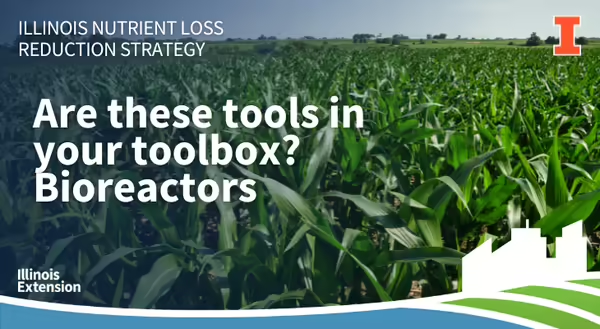
Bioreactors, an emerging edge-of-field practice, are becoming more prominent in agricultural settings. Dr. Reid Christianson, former research assistant professor of Crop Sciences at University of Illinois, and Dr. Bryan Maxwell, a visiting assistant research scientist at the Illinois Sustainable Technology Center, explain how bioreactors work and the steps towards getting one installed.
What are bioreactors?
Dr. Christianson explained that a bioreactor is a hole in the ground filled with woodchips that obtains water from subsurface or tile drainage systems and is an Illinois Nutrient Loss Reduction Strategy-approved practice. Different kinds of woodchips as well as their compaction affects the efficiency of the bioreactor. He explained that there is a balance between how much water enters the bioreactor and how well it treats the water. It is important to note that bioreactors are not designed to treat every drop of water leaving the field. Their research suggested that wider bioreactors treat more water less efficiently, thus having lower nitrate reductions. Longer bioreactors have better effects on lower water volumes but bypass a lot more drainage water. The goal is to optimize this balance.
Bioreactors are generally very effective at reducing nitrate concentrations. The bioreactor can reduce nitrates by 40-80%. Unfortunately, the bioreactor is unable to treat all water during times of high flow, so some water will travel through a bypass to not back up water in the field. The nitrate reduction from the bioreactor combined with the untreated water that flows through the bypass results in an average efficiency of a 25% reduction.
Cost, construction, and logistics
A large amount of the cost of a bioreactor will stem from the woodchips. High-quality large woodchips, 2-3 inches in diameter with no debris will last around ten years and perform better but tend to be expensive. Fortunately, upkeep tends to be very minimal. One possible management component is to drain the water during the summer. Producers can opt for a draw-out plate, which is an upside-down V-shaped piece at the bottom to assist with drainage. Woodchips will need to be replaced approximately every 10 years to ensure optimal function of the bioreactor.
It is recommended by both Dr. Maxwell and Dr. Christianson that those interested in installing bioreactors should follow the guidance of the Natural Resources Conservation Service (NRCS). The NRCS or the county Soil and Water Conservation District (SWCD) can do a site visit, help design a plan, and discuss the financial assistance available under USDA programs.
With any large-scale operation, being familiar with your land before moving forward is imperative. Dr. Maxwell noted that bioreactors are not intended to catch surface runoff with a lot of erosion. A bioreactor’s size depends on the drainage area's size. A bioreactor is an edge-of-field practice, so it won’t take land out of production, but it needs to be placed in an area that is out of the path of equipment. The tile drainage layout should also be identified so the bioreactor can be tied into the system.
Considerations
It is key to not overwhelm yourself with the idea of a bioreactor. Your local NRCS, SWCD, and Illinois Extension offices are all available to help. Also, keep in mind that there are a variety of cost-share opportunities that may be available to you to help offset the cost of the bioreactor and the installation process.
Listen to the full podcast interviews with Dr. Christianson, Dr. Maxwell, and Drew Hohenboken, a farmer from Rock Island County, and learn about the bioreactor on Hohenboken’s farm.
ABOUT THE AUTHORS
Rachel Curry is an Agriculture and Agribusiness Educator for two Nitrogen Priority Watersheds (Flint-Henderson and Lower Rock River Watersheds) and is housed in the Galva office of the Henry, Mercer, Rock Island, and Stark Counties Extension Unit. Rachel earned a B.S. in Environmental Studies from Knox College and an M.S. in Environmental Science and Soil Science from Iowa State University with an emphasis on soil fertility. She is interested in sharing information on the Illinois Nutrient Loss Reduction Strategy and agricultural conservation practices through discussion and outreach.
Nicole Haverback is a Watershed Outreach Associate for two Phosphorus Priority Watersheds (Embarras and Little Wabash River Watersheds) and is housed in the Effingham office of the Clay, Effingham, Fayette, and Jasper Counties Extension Unit. Nicole earned a BS in Agriculture and Rural Policy Studies from Iowa State University in May of 2022. She is interested in sharing information on the Illinois Nutrient Loss Reduction Strategy and agriculture conservation practices through discussion and outreach.
Sam Henry is an Agricultural Engineering student at the University of Illinois. Outside of classes, she works with Dr. Rodriguez in his BioMASS Lab, and learns about alternative agricultural methods in Illini Urban Farmers. She is in her third year, and is passionate about the nexus of clean water, sustainable agriculture, natural resources, and sustainability.
ABOUT THE BLOG
At Illinois Extension, we’re working to improve water quality at home and downstream. Every month, our watershed outreach associates will bring you stories highlighting agricultural conservation practices, current research projects and results, and from the field farmer interviews. The Nutrient Loss Reduction blog covers conservation practices recommended by the Illinois Nutrient Loss Reduction Strategy, timely updates, farm safety, and new decision tools to help farmers and producers reduce the nutrients leaving their field. Want to get notified when new blog posts are available? Subscribe at go.illinois.edu/SubscribeINLRS.